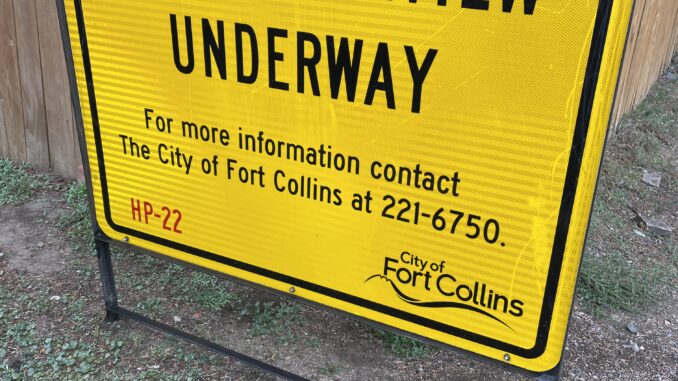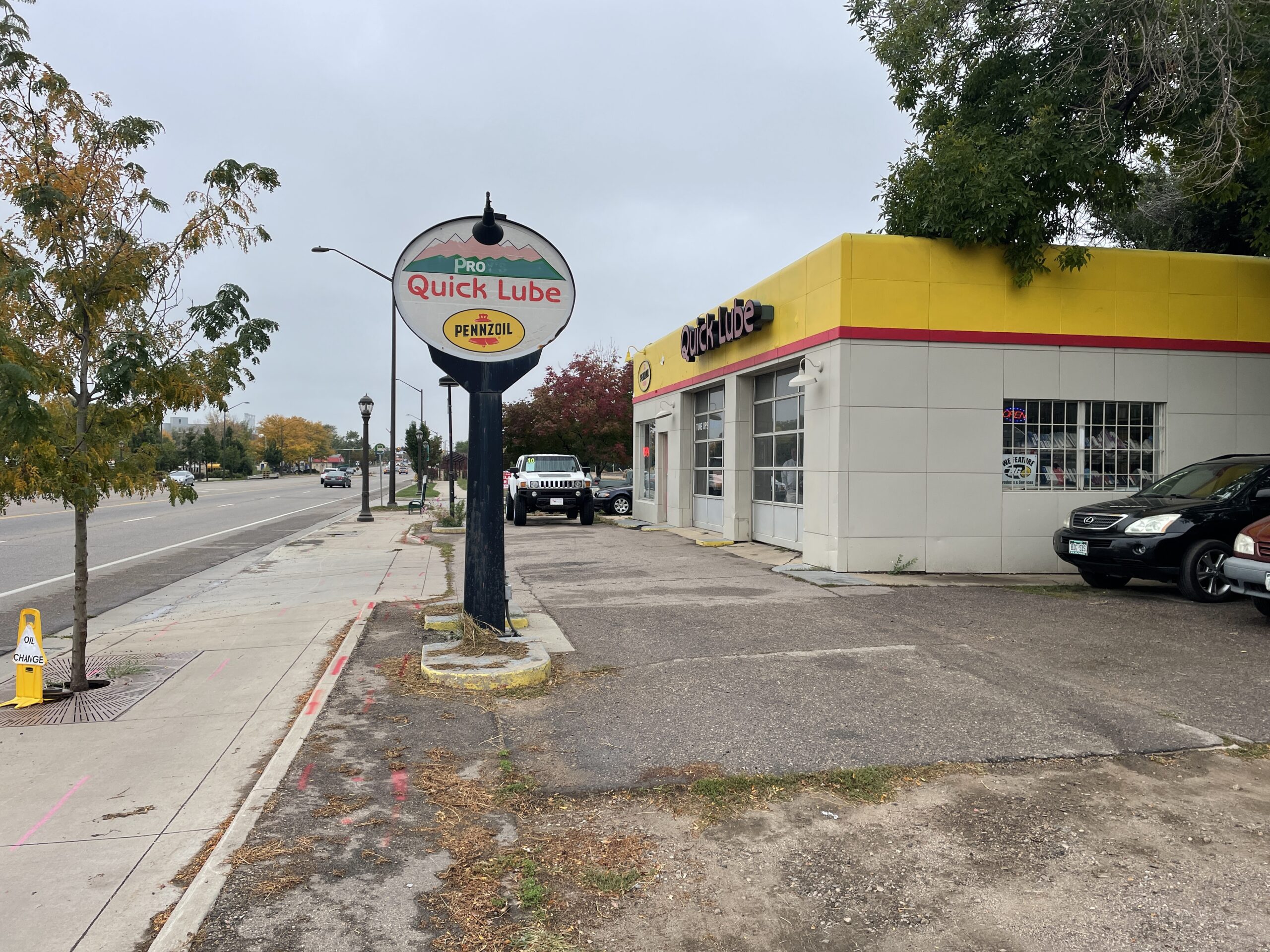
A Fort Collins couple trying to sell a piece of property on North College recently learned that history has a way of catching up with you. The couple asked to not have their names used in this article and are referred to as the property owner throughout.
“We put the property on the market, a client comes in and was making plans with the property, then Fort Collins comes in and decides after that it should be a part of the Fort Collins Preservation Society, not before,” the property owner said.
The property in question sits at 829 N. College Ave. Since it was first constructed in 1937, it has undergone many different names from M-K Filling Station, M-K Coal & Oil Co, North College Standard Service, Amoco Service Station, to Quick Lube, which is what it is today. In addition to the service station, there is also a farmhouse that serves as a residence on the property, as well.

“They’re saying that the site is the first ever gas station in Fort Collins, however, it wasn’t even Fort Collins until 1937, that’s when the city annexed that area. They’re claiming it was a gas station before then, which is impossible. But I have photos with write-ups indicating that the building was bulldozed several times and that the building is as new as 1970,” the property owner said.
A hearing has been set for October 19 to determine whether the buildings are part of the historical preservation designation, and the hearing is going to be looking at the history and deciding if the history of the property is significant. The commission hearing is an appeal of staff findings, originally put forth by the Colorado Department of Transportation back in 2010 and further backed by the Fort Collins Historic Preservation Society.
“The city claimed the reason they never got in touch with us about it until now is because the potential sale of this property triggers them to come in and try to figure out if the site is historical or not. And the reason they didn’t contact me back in 2001 when I purchased the property was because the historical preservation society didn’t exist back then,” the property owner said.
Before retirement, the property owner was involved in real estate and was a broker, but now he and his wife primarily buy homes for the purpose of fixing them up and renting them out, which the property owner said was their plan for retirement until plans had to change, adding that while the city is telling the property owner they can’t demolish a structure on one of their properties, plans are already underway by the city to demolish a historical structure on another one of the property owner’s parcels of land in south Fort Collins.
“So we planned for when we got to retirement, that would be our retirement income, the rent from these houses but when you have the city bulldozing one and telling you that you can’t bulldoze the other one, it kind of messes up your retirement,” the property owner said. “On South College at the corner of College and Trilby, right now the city is taking properties to widen that road. Part of the properties is one of mine, which is a house that was built in 1920, it was the first farmhouse in south Fort Collins, which in every way would qualify for historical preservation. They’re not trying to preserve that; they’ve already got a schedule to bulldoze it.”
According to the property owner, they had a potential buyer lined up to purchase their property on North College where the service station and farmhouse currently sit and everything was underway until that potential buyer started applying for applications and that’s when the city got involved to inform them that those structures had been determined to be historic and therefore could not be demolished.

“The potential buyer went to the city to apply for specific use for the property, which the zoning was fine, but the buyer wanted to find out what they would have to do build what they wanted to build there, and then the city suddenly said, ‘no, we won’t let anybody tear that down, we consider that part of the Fort Collins Historical Landmark. They claim in a letter that backs in 2010 CDOT designated this as a historical building,” the property owner said.
Senior historic preservation planner Jim Bertolini has been directly involved in the case. It will be much of his findings under review for the October hearing. According to Bertolini, CDOT was responsible for the initial determination of the property’s historic status and would have been using federal funding as part of their project funding to widen portions of North College, which came with federal responsibilities that included the National Preservation Act.
“Similar to what Fort Collins requires of developers, Federal law requires federal agencies or people using federal funding to go through the same kind of process by determining what nearby properties are going to be affected by the project and are any of them historic and if they are, is the project having a negative effect on them. That’s how the city was able to lean on information from CDOT because each project was asking the same question, just in a different project context,” Bertonlini said.
Bertonlini said that anytime there is a development project, that development application goes to the city and then gets routed to all of the different city departments and in this case, the developers that were looking at purchasing the property did what is called a conceptual review, which Bertolini said frequently happens before the purchase of a property. That’s basically asking if a project is going to be put in place, what are the responsibilities under the city’s land use code and what needs to be done in order for a particular type of project to be done at the proposed location.
“One of those responsibilities is that if you’ve got a property that already has something built on it that’s over 50 years of age, they have to go through a historical review process. We then figure out, ‘does this property qualify as a city landmark,’ if it meets those qualifications then our land use code really expects that the historic resource be incorporated into the project. Our land use code really prefers to see adaptive reuse rather than full demolition,” Bertolini said. “In this case, the Colorado Department of Transportation had already completed a survey back in 2010 as part of a Federally funded transportation project on a section of College Avenue, so they were already responsible for doing some research anyway. So, we picked up that old survey form, updated it with new information, and our conclusion, as staff, was that this property qualified under several city standards, so a full demolition would not be in our land use code.”
The property owner said that while the city’s information may be accurate, they feel as though it’s being manipulated and used to the city’s benefit and cites that when the CDOT project on North College was taking place to expand the road, 25 feet of the property was taken from him off what is being considered historical property. The property owner cites other instances where they feel similar situations have taken place.
“Also, in Loveland about eight years ago did eminent domain on an entire block from Cleveland to Lincoln and from First to Second, almost Third, about a block and a half. They took property from 19 homeowners. One of those property owners was a gas station that we owned that had been there since the ‘20s or ‘30s and they didn’t care, they took it from us and bulldozed that thing right down to the ground. But now that we want to do it, it’s different,” the property owner said.
Bertolini said that there are federal agencies such as CDOT that are in a position to determine whether or not projects have a large enough benefit to the public to bypass regulations that private developers would otherwise face. Bertolini further added the importance of understanding why the land use code is in place, to begin with.
“Federal agencies like CDOT can absolutely say that we need to go ahead and damage or destroy this historical resource because this project has the public benefit, and we need to get it done,” Bertolini said. “So, the intent behind making developing projects responsible for their effects on historic resources is to make sure that we’re maintaining these connections to people who came before, people who built our community, their experiences, and the things they left behind for us. We’re trying to maintain a visible connection to what they did and to our own identity and to the folks that live in Fort Collins and northern Colorado, so the intent behind the code division is to make sure that we’re maintaining that connection and doing our part of doing that.”
For more information about the City of Fort Collins, Historic Preservation visit fcgov.com/historicpreservation.
Support Northern Colorado Journalism
Show your support for North Forty News by helping us produce more content. It's a kind and simple gesture that will help us continue to bring more content to you.
BONUS - Donors get a link in their receipt to sign up for our once-per-week instant text messaging alert. Get your e-copy of North Forty News the moment it is released!
Click to Donate
